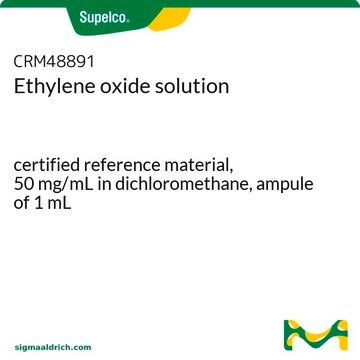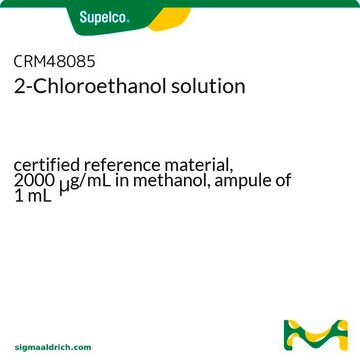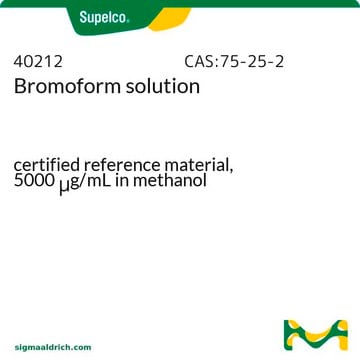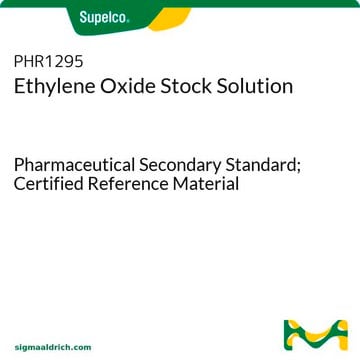If this product has an expiration or retest date, it will be shown on the Certificate of Analysis (COA, CofA). If there is no retest or expiration date listed on the product's COA, we do not have suitable stability data to determine a shelf life. For these products, the only date on the COA will be the release date; a retest, expiration, or use-by-date will not be displayed.
For all products, we recommend handling per defined conditions as printed in our product literature and website product descriptions. We recommend that products should be routinely inspected by customers to ensure they perform as expected.
For products without retest or expiration dates, our standard warranty of 1 year from the date of shipment is applicable.
For more information, please refer to the Product Dating Information document: https://www.sigmaaldrich.com/deepweb/assets/sigmaaldrich/marketing/global/documents/449/386/product-dating-information-mk.pdf
48838
Óxido de etileno solution
certified reference material, 50 mg/mL in methanol
Seleccione un Tamaño
Seleccione un Tamaño
About This Item
Productos recomendados
grado
certified reference material
TraceCERT®
Línea del producto
TraceCERT®
CofA
current certificate can be downloaded
Características
standard type calibration
envase
ampule of 1 mL
concentración
50 mg/mL in methanol
técnicas
HPLC: suitable
gas chromatography (GC): suitable
aplicaciones
agriculture
cleaning products
cosmetics
environmental
food and beverages
personal care
Formato
single component solution
temp. de almacenamiento
2-8°C
cadena SMILES
C1CO1
InChI
1S/C2H4O/c1-2-3-1/h1-2H2
Clave InChI
IAYPIBMASNFSPL-UHFFFAOYSA-N
¿Está buscando productos similares? Visita Guía de comparación de productos
Descripción general
El óxido de etileno es un líquido tóxico e inflamable, que puede obtenerse mediante oxidación en fase de vapor del etileno.[1] Puede utilizarse en la síntesis de etilenglicol[2], éteres glicólicos, tensioactivos y etanolaminas.[1] Es un compuesto químico importante desde el punto de vista industrial que puede utilizarse como fumigante para esterilizar equipos odontológicos y médicos.[2]
Aplicación
Otras notas
Información legal
Palabra de señalización
Danger
Frases de peligro
Consejos de prudencia
Clasificaciones de peligro
Acute Tox. 3 Dermal - Acute Tox. 3 Inhalation - Acute Tox. 3 Oral - Carc. 1B - Eye Dam. 1 - Flam. Liq. 2 - Muta. 1B - Repr. 1B - Skin Corr. 1 - STOT RE 2 - STOT SE 1
Órganos de actuación
Eyes,Central nervous system, Nervous system
Código de clase de almacenamiento
3 - Flammable liquids
Clase de riesgo para el agua (WGK)
WGK 3
Punto de inflamabilidad (°F)
50.0 °F - closed cup
Punto de inflamabilidad (°C)
10 °C - closed cup
Equipo de protección personal
Eyeshields, Faceshields, Gloves
Elija entre una de las versiones más recientes:
Certificados de análisis (COA)
It looks like we've run into a problem, but you can still download Certificates of Analysis from our Documentos section.
Si necesita más asistencia, póngase en contacto con Atención al cliente
¿Ya tiene este producto?
Encuentre la documentación para los productos que ha comprado recientemente en la Biblioteca de documentos.
Los clientes también vieron
-
How can I determine the shelf life / expiration / retest date of this product?
1 answer-
Helpful?
-
-
How is shipping temperature determined? And how is it related to the product storage temperature?
1 answer-
Products may be shipped at a different temperature than the recommended long-term storage temperature. If the product quality is sensitive to short-term exposure to conditions other than the recommended long-term storage, it will be shipped on wet or dry-ice. If the product quality is NOT affected by short-term exposure to conditions other than the recommended long-term storage, it will be shipped at ambient temperature. As shipping routes are configured for minimum transit times, shipping at ambient temperature helps control shipping costs for our customers. For more information, please refer to the Storage and Transport Conditions document: https://www.sigmaaldrich.com/deepweb/assets/sigmaaldrich/marketing/global/documents/316/622/storage-transport-conditions-mk.pdf
Helpful?
-
-
Please supply detailed instructions how to open and extract the chemical from its packing container. The form of the vial is not familiar to me and due to chemical's high toxicity and volatile content we need to handle it with extra care.
1 answer-
The ampule may be opened by holding the top firmly with one hand and the body of the ampule in the other hand. Firmly and steadily bend the cap away from the break point or neck until the vial snaps. Dispose of the cap (containing the broken vial top) into a sharps bin. The item is intended for single-use only. Please review the product SDS for recommended personal protective equipment.
Please see the links below to review products that may be useful in opening ampules:
https://www.sigmaaldrich.com/product/aldrich/z693847
https://www.sigmaaldrich.com/substance/ampulebreakercollar1234598765Helpful?
-
Active Filters
Nuestro equipo de científicos tiene experiencia en todas las áreas de investigación: Ciencias de la vida, Ciencia de los materiales, Síntesis química, Cromatografía, Analítica y muchas otras.
Póngase en contacto con el Servicio técnico










